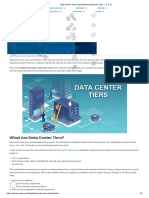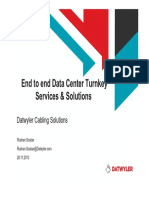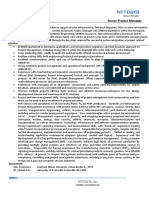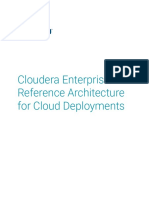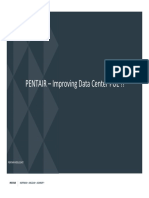Data Center from Conception to Operation In 30 minutes or less
What is a Data Center? A data center is a facility used for housing electronic equipment, typically computers and communications equipment. Data centers can be private, serving a single company or, public serving several companies. Practically every company that is mid-sized or larger has some kind of data center.
Joe Joplin Data Center from Conception to Operation
�What type of Data Center are you designing? The Uptime Institute created a 4 Tier rating system of data centers, Tier-1 to Tier-4. Tier-1 data centers are the most basic while a Tier-4 is fundamentally immune to planned and unplanned downtime. Avoid terms like near Tier-3 data center and Tier-3 plus. These classifications do not exist. The Institute has revised its standards to better explain their ratings. The rating system is an absolute. You are only as good as your weakest link.
Joe Joplin Data Center from Conception to Operation
SOURCE: Uptime Institute warns against tier standard misuse, Matt Stansberry, 27 Apr 2006, SearchDataCenter.com
�Tier I - Basic Site
Non-redundant capacity components Single non-redundant path distribution paths
Cabling Power Cooling
Performance Test
Any capacity component failure will impact the computer systems. Any distribution path failure will impact the computer systems.
Planned work will require most or all of the systems to be shut down 99.671% availability
equivalent of 28.8 hours of annual downtime or 4.74 min/day
Joe Joplin Data Center from Conception to Operation
SOURCE: Industry Standard Tier Classification, Uptime Institute, www.upsite.com/TUIpages/tuiwhite.html
�Tier II - Redundant Capacity Components
Redundant capacity components Single non-redundant distribution paths Performance Test
Any capacity component failure may impact the computer systems. Any distribution path failure will impact the computer systems.
Redundant UPS modules and engine generators are required
Redundant Cooling units, chillers, and pumps.
Planned work will require most or all of the systems to be shut down 99.741% availability
equivalent of 22.7 hours of annual downtime or 3.73 min/day
SOURCE: Industry Standard Tier Classification, Uptime Institute, www.upsite.com/TUIpages/tuiwhite.html
Joe Joplin Data Center from Conception to Operation
�Tier III - Concurrently Maintainable
Redundant capacity components Multiple distributions paths One active path Performance Test
A capacity component can be removed without impacting the system A distribution path can be removed without impacting the system
Dual power inputs required for all computer hardware Planned work will not require the systems to be shut down
But may elevate the risk of disruption
99.982% availability
equivalent of 1.6 hours of annual downtime or .26 min/day (15.6 sec/day)
SOURCE: Industry Standard Tier Classification, Uptime Institute, www.upsite.com/TUIpages/tuiwhite.html
Joe Joplin Data Center from Conception to Operation
�Tier IV Fault Tolerant
Redundant capacity components Multiple distributions paths Multiple active paths Performance Test
A single worst-case failure of any capacity system or distribution element will not impact the computer system Any capacity component or distribution path can be removed without impacting the computer system
Dual power inputs required for all computer hardware Planned work will not require the systems to be shut down 99.995% availability
equivalent of .4 hours of annual downtime or .07 min/day (4.3 sec/day)
SOURCE: Industry Standard Tier Classification, Uptime Institute, www.upsite.com/TUIpages/tuiwhite.html
Joe Joplin Data Center from Conception to Operation
�Performance Standard by Tier Level
Tier Requirement Source System Component Redundancy Distribution Paths Compartmentalization Concurrently Maintainable Fault Tolerance Tier 1 Tier II Tier III System N+1 1 normal and 1 alternate Yes Yes No Tier IV System + System Minimum of N+1 2 simultaneously active Yes Yes Yes
Joe Joplin Data Center from Conception to Operation
System System N 1 No No No N+1 1 No No No
SOURCE: Industry Standard Tier Classification, Uptime Institute, www.upsite.com/TUIpages/tuiwhite.html
�Tier Level Design
You are only as good as your weakest link To meet a tier level you must pass the performance test Each tier represents an infrastructure topology Tier 1 and Tier II solutions are to support current IT Technology.
First Dedicated spaces for computer equipment Typical components for an improvement environment
UPSs, dedicated cooling systems, engine generators
Tier III and Tier IV solutions are long term solutions to outlast current IT Technology
Tier III introduces concurrent maintenance to every component Tier IV introduces fault tolerance to every component
Joe Joplin Data Center from Conception to Operation
�Two Primary Design Concepts Power Cooling
Joe Joplin Data Center from Conception to Operation
�Power Calculations
Current Load for Critical Equipment
Servers, routers, computers, storage devices, telecommunications equipment, etc.
Future Load for Critical Equipment Load for UPS & Batteries Load for non-critical Equipment
Lighting, Security, Fire, Monitoring, etc.
Load for Cooling Demands
Joe Joplin Data Center from Conception to Operation
�Current Load for Critical Equipment
TYPICAL RACK Component Switch Router Blade Server 7U 4836 W TOTAL 200 W .67 x 120V x 2A Nameplate Rating 67% (Volts x Amps) Load (kW) 0.20 0.16 4.84 5.20
Current Load = 6 Racks x 5.2 kW = 31.2 kW
Joe Joplin Data Center from Conception to Operation
�Future Load for Critical Equipment Estimated that equipment will be increased by 33% in the next 3 years Future Load = Current Load x 33% Future Load = 31.2 kW x 33% = 10.3 kW
Joe Joplin Data Center from Conception to Operation
�Load for UPS & Batteries
UPS
Support Critical Loads from power outages & anomalies Effectively pass through 85% of the input power UPS Load = 15 % x (Current Load + Future Load) UPS Load = .15 x (31.2 kW + 10.3 kW) = 6.23 kW
Batteries
Charging load to be 20% after a full or partial discharge Battery load = 20% x (Current Load + Future Load) Battery load = .20 x (31.2 kW + 10.3 kW) = 8.30 kW
Joe Joplin Data Center from Conception to Operation
�Loads for non-critical Equipment Lighting based on average consumption
2 watts per square foot 100 ft2 x 2 W/ft2 / 1000 = .20 kW
Security, Fire, and Monitoring Systems
Total of the nameplate ratings (600 W + 250 W + 250 W) / 1000 = 1.1 kW
Total non-critical Load = .20 kW + 1.1 kW = 1.3 kW
Joe Joplin Data Center from Conception to Operation
�Peak Power Draw Peak power draw
(Current Load + Future Load) x Power Factor (31.2 kW + 10.3 kW) x 1.05 = 43.58 kW
Additional power needed
Peak power draw Steady State Load 43.58 (31.2 kW + 10.3kW) = 2.08 kW
Joe Joplin Data Center from Conception to Operation
�Total Load Calculations
Current Load = 31.20 kW Future Load = 10.50 kW UPS Load = 6.23 kW Batteries Load = 8.30 kW Non-critical load = 1.30 kW Peak Power Adj. = 2.08 kW TOTAL POWER = 59.40 kW
Joe Joplin Data Center from Conception to Operation
�Cooling Power Load
Cooling systems vary in their efficiencies
Direct Expansion systems (DX) are less efficient
operating at a 1:1 ratio to peak load supported
Chilled Water systems are more efficient
operating at a 7:10 ratio to peak load supported
Assuming the worst case scenario of 1:1 Cooling requirement will be 100% of the Total Load
1 x 59 kW = 59 kW
Joe Joplin Data Center from Conception to Operation
�Power Usage by Category
Critical Future UPS Batteries Lighting Security Peak Adj Cooling
Joe Joplin Data Center from Conception to Operation
�Total Power Requirements
Total Power = Total Load + Cooling Load
Total Power = 59.4 kW + 59.4 kW 120 kW
Total Power Required
NEC Code requires a 125% of the Total Power 1.25 x 120 kW = 150 kW
Electric Service needed
480V Three-Phase Service Current = (kW x 1000) / (Volts x 1.73) Current = (150 kW x 1000) / (480 V x 1.73) 180 A
Joe Joplin Data Center from Conception to Operation
�Calculating Generator Size
Category Critical Load Future Load UPS Batteries Lighting Peak Adjustment Cooling Load 31.20 10.30 6.23 8.30 0.20 2.08 59.40 Factor 1.3 1.3 1.3 1.3 1.3 1.3 1.5 Generator Load 40.57 13.39 8.09 10.79 0.26 2.70 89.10 164.89
Joe Joplin Data Center from Conception to Operation
TOTAL Generator Load
�Calculating Generator Size Calculated Size 165 kW Generators are typically classified by kVAs
The type power factor for these ratings is .8
Determine the power factor for your generator
Generator Size = 165kW / .8 200 kVA
Joe Joplin Data Center from Conception to Operation
�Electrical System Tier 1
AC 208V/480V Gen N
Utility Switch Gear
Mech Switch Gear UPS N Mech System
UPS Output Switch Gear
PDU
Equipment
SOURCE: Industry Standard Tier Classification, Uptime Institute, www.upsite.com/TUIpages/tuiwhite.html
Joe Joplin Data Center from Conception to Operation
�Electrical System Tier 2
AC 208V/480V Gen N Gen +1
Utility Switch Gear
Gen Switch Gear
Mech Switch Gear UPS N UPS +1 Mech System
UPS Output Switch Gear
PDU
Equipment
SOURCE: Industry Standard Tier Classification, Uptime Institute, www.upsite.com/TUIpages/tuiwhite.html
Joe Joplin Data Center from Conception to Operation
�Electrical System Tier 3
AC 208V/480V Gen N Gen +1 AC 208V/480V
Utility Switch Gear
Gen Switch Gear
Utility Switch Gear
Mech Switch Gear UPS N UPS +1 Mech System
Mech Switch Gear
UPS Output Switch Gear
Critical MCC Critical Fan or Pump
Critical MCC
ALT Output Switch Gear
PDU
Equipment
PDU
SOURCE: Industry Standard Tier Classification, Uptime Institute, www.upsite.com/TUIpages/tuiwhite.html
Joe Joplin Data Center from Conception to Operation
�Electrical System Tier 4
AC 208V/480V Gen N Gen +1 Gen N Gen +1 AC 208V/480V
Utility Switch Gear
Gen Switch Gear
Gen Switch Gear
Utility Switch Gear
Mech Switch Gear UPS N UPS +1 Mech System
Mech Switch Gear UPS N UPS +1
UPS Output Switch Gear
Critical MCC Critical Fan or Pump
Critical MCC
ALT Output Switch Gear
PDU
Equipment
PDU
SOURCE: Industry Standard Tier Classification, Uptime Institute, www.upsite.com/TUIpages/tuiwhite.html
Joe Joplin Data Center from Conception to Operation
�Cooling Key Components
Physical Layout
Hot Aisle Cold Aisle
Air flow control
Substantial air flow
Consistent Maintenance
Cooling systems rarely provide diagnostics for proactive warnings
Joe Joplin Data Center from Conception to Operation
�Physical Layout
Hot Aisle Cold Aisle
Industry Standard for all equipment
Draw in cool air from the front and expel hot from the rear
Align your cabinets with the floor tiles
Keep at least 4 open (2 tiles) on your Cold Aisle Keep at least 3 open (1 tile) on your Hot Aisle
Create a Floor Master plan Put heavy/hotter equipment on the bottom of your racks Distribute power consumption (heat) evenly among your racks Cabling should be routed between racks or in the hot aisles
Avoid air damns on the front of your equipment
Place Cooling Units at the end of the Hot Aisles
Joe Joplin Data Center from Conception to Operation
�Air flow control
FRONT VIEW
MIXING AIR
REAR
SIDE VIEW
FRONT
Joe Joplin Data Center from Conception to Operation
�Air flow control
FRONT VIEW
FRONT
REAR REAR REAR
SIDE VIEW
FRONT
FRONT
Joe Joplin Data Center from Conception to Operation
�Air Flow Control
Raised Floor
4'-0"
RACK
RACK
12'-0"
PERFORATED TILES DATACOM CABLES POWER CABLES DATACOM CABLES
Joe Joplin Data Center from Conception to Operation
�Air Flow Control
Overhead Cabling
POWER CABLES
DATACOM CABLES
DATACOM CABLES
RACK
RACK
4'-0"
12'-0"
Joe Joplin Data Center from Conception to Operation
�Air Flow Control
Overhead Cabling
SOURCE: Liebert, XDO Overhead Cooling Module, http://www.liebert.com/assets/products/english/products/env/xtreme/60Hz/bro_2pg/acrobat/sl_16660.pdf
Joe Joplin Data Center from Conception to Operation
�Air Flow Control
Overhead Cabling
SOURCE: PANDUIT FIBERRUNNERTM and OPTICOMTM HD Cable Management Rack System
Joe Joplin Data Center from Conception to Operation
�Air Flow Control
The Uptime institute found that 78% of the total bypass airflow is caused by unsealed cabling holes in the raise floor
Which Allows cold air to circulate directly into the hot aisle
Maximum perforated tiles
Equaled to the total cooling unit airflow divided by 750
Total CFM must equal or exceed your equipment total
Joe Joplin Data Center from Conception to Operation
�Consistent Maintenance
In a recent study by the Uptime Institute of 19 Data Centers
10% of the cooling units had failed, be were not providing an alarm
Monitor power usage compared to cooling capicity
Your total kilowatts per hour should not exceed 50% of your total cool capacity
Regular scheduled checks and maintenance
Weekly system checks Bi-Annual on-site maintenance
Joe Joplin Data Center from Conception to Operation
�Questions Thank you for your attention
Joe Joplin Data Center from Conception to Operation
�Sources
Uptime Institute Whitepapers
http://www.upsite.com/TUIpages/tuiwhite.html
APC UPC Selector Sizing Applications
http://www.apcc.com/template/size/apc/index.cfm
Dell configuration Spread sheet
http://www.dell.com/downloads/global/products/pedge/en/DellConfigCalculat or.xls
Power Calculation
http://lms.globalknowledge.com/ilearn/en/learner/jsp/clients/APC/customer/re gister.jsp?tsk=
Joe Joplin Data Center from Conception to Operation























































